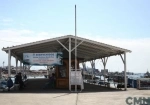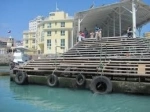Passenger Pier Port of Iquique. Iquique - CHILE
Direccion:
Iquique The cove of Iquique was populated from the indigenous pre-Hispanic period for having engaged in the extraction of guano covaderas. On arrival of the Spanish this activity was enhanced by the use of black slaves and "Indians commissioned". Since 1566, exploited the silver mines located nearby, but was in the nineteenth century through the exploitation of nitrate to Iquique made the leap to an urban entity itself. Until that time the population, without even a thousand people lived scattered in different sections of the creek.
The exploitation of nitrate began about 1810, production is shipped by Iquique to Lima where it is used to make gunpowder. In 1830 the first accomplished by sending Iquique nitrate to Europe, leading to accelerated development of the port and city. In 1855 he was declared Puerto Iquique Mayor; sailing from here nitrate production in the province of Tarapaca, which rose 73,000 tonnes in 1840 to 500,000 in 1870. The port also reached the water brought in schooners from Arica. In 1879 the port is blocked by the Chilean Navy, because the Pacific war which will result in the incorporation of the province of Tarapaca to the Republic of Chile in 1883.
Between 1880 and 1920 is lived heyday of nitrate. In 1894 the municipal budget Iquique per capita was 2.38 times that of Santiago, and in 1900 the port of Iquique 4.10 times the amount collected in fiscal revenues collected in Valparaiso. Population growth is also strong in this period, from 15,391 inhabitants in 1885 to 40,171 in 1907. The city-port of the "capital of nitrate, then develops the historical and architectural heritage that can be seen today and is transformed into a cosmopolitan city with a high proportion of foreign population. It attracts many people and thus becomes the site of landfall bound passenger vessels.
The transportation of passengers between the docks and sailboats and steamers anchored in the bay by motorboat or rowing boats. Facing increased movement of passengers, the port authority decided to build a mooring dock for the loading and unloading of passengers more easily, safely and quickly. It is a Douglas fir construction on steel columns. Its roof is pressed and ends in a large triangle which is a kind of bow. In four of its sides has stairways down to the sea
In 1931 he built a new dock but the former was not destroyed. Today the elegant pier is used by smaller vessels such as boats and fishing schooners that offer cruises in the bay. It is part of the historic district next to the old customs building, the old houses adjoining, and the former railway station.



